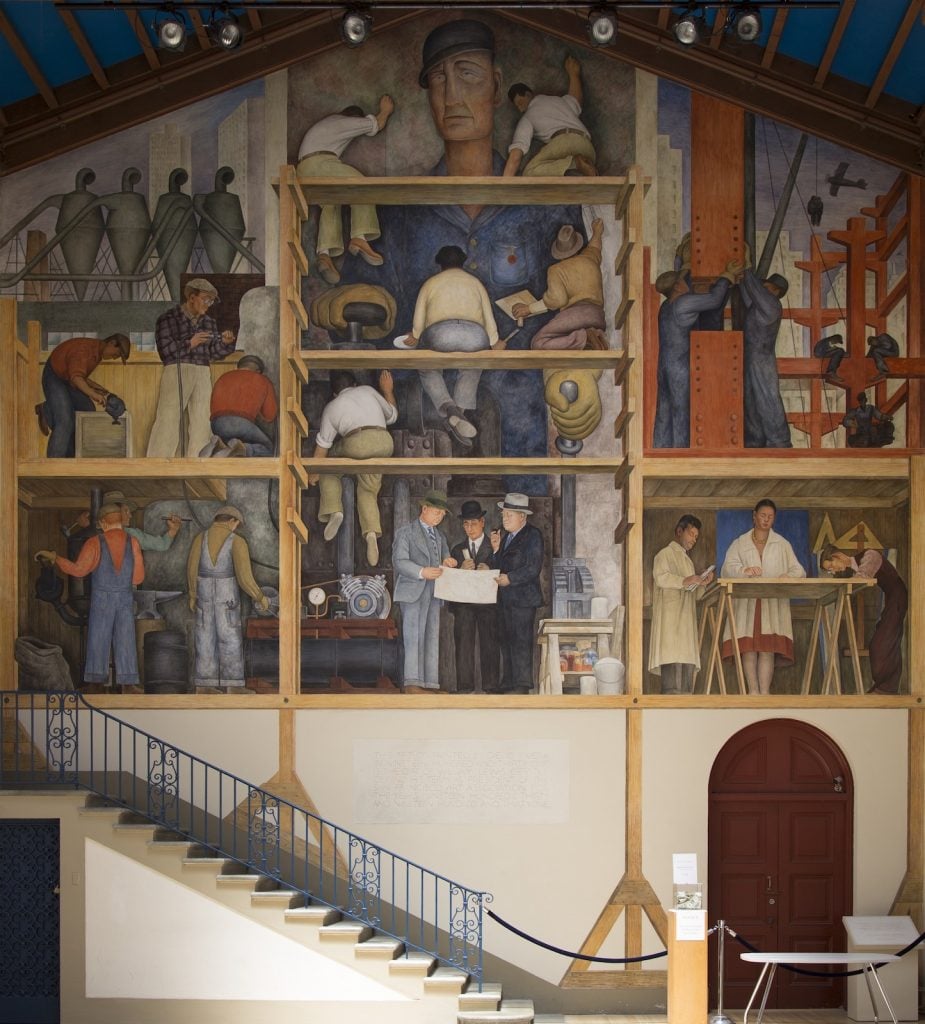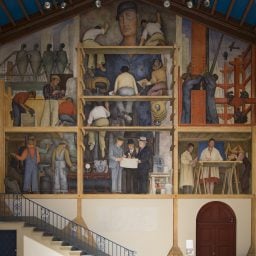A mammoth fresco by Diego Rivera at the cash-strapped San Francisco Art Institute that the school’s board was considering selling to pay down its mountain of debt may soon be designated as a landmark.
That proposal came one step closer to becoming a reality after the city’s board of supervisors unanimously agreed on January 12 to a landmark-designation motion put forward by city supervisor Aaron Peskin.
The battle over the fresco, which was reportedly going to be sold to George Lucas for his forthcoming Los Angeles museum, is now heating up as activists make loud calls for any discussion of the sale to be halted, while others throw allegations of racism at the school board.
Among those who stand against the sale is artist Catherine Opie, who graduated from SFAI in 1985. On June 7, she issued an open letter to the school board, calling the possible sale an “incredibly unconscionable decision.”
“Of course, I want SFAI to survive, but not by gutting one of the most important artworks in the history of the institution,” she wrote. “Quite frankly, this is sickening.”
Opie has since pulled one of her photographs from an upcoming, as-yet-unannounced benefit auction for the school.
“Artists are asked to be philanthropists,” she wrote. “It is truly important that my work can create an ability of helping organizations with their future. The board of trustees has abused this in not making the gesture of donations themselves.”
“We share Ms. Opie’s assessment that our Diego Rivera mural goes far beyond being a financial asset of the institution,” Doug Hall, an SFAI board member and professor, said in a statement issued to Artnet News. “As fiduciaries, the board, however, is required to put forward, assess, and review all channels to save the school and secure its long-term viability.”
“The future of the mural is closely intertwined with the future of the school—if SFAI cannot get back on our feet financially and rebuild our program, we can no longer protect and preserve the mural, as we have for the past 90 years,” he added.
Meanwhile, Cristóbal Martínez, a current faculty member, alleged in a letter to Peskin that the school’s failure to consult with Chicanx and Indigenous communities about the mural amounts to racism.
The fight came to a head on Monday night during a public hearing, during which a string of current and former faculty members spoke in favor of the landmark designation. Several speakers argued that Rivera’s work has major significance to the Latinx and Chicanx communities of San Francisco, and that selling it off would betray them.
Selling the mural, said faculty member Lindsey White, would be defacing one of the school’s main assets.
But the school’s administrators say that taking one of its greatest financial assets off the table would have potentially devastating consequences. In a written statement provided to Artnet News in lieu of an interview, SFAI board chair Pam Rorke Levy said she asked the city’s supervisors to delay landmarking the mural so the school could use it to secure a $7 million bridge loan.
In October, when creditors were about to foreclose on the school’s property, the University of California’s board of regents stepped in and bought the school’s debt. The regents now own the building it is in, and SFAI has a six-year lease.
If the school does not pay off the debt within that time, it permanently cedes the property to the University of California. If it doesn’t sell or move the mural, it, too, goes to the school.
According to Levy, the state is not bound by city landmark designations, suggesting that if the University of California takes possession of the artwork, they can do with it what they wish.
But her claims found no favor in the city supervisors’ decision, which initiates what may be a months-long process.
SFAI’s $19.7 million debt—a figure that far exceeds its endowment—stems from an expansion project that its critics call ill-advised. After the coronavirus pandemic forced the school to close temporarily, its administrators said they saw no clear path to reopening.
After nationwide headlines announced that the 150-year-old institution was closing, the board changed direction, saying the pandemic allowed for a much-needed “time out.”
The Making of a Fresco Showing the Building of a City (1931) is one of three murals Rivera painted in San Francisco, and depicts his assistants working on the mural itself, with Rivera gazing upwards. Also depicted are local historical figures like the designer of the San Francisco Stock Exchange, where Rivera also painted a mural; the school’s then-president; and various architects and artists.









